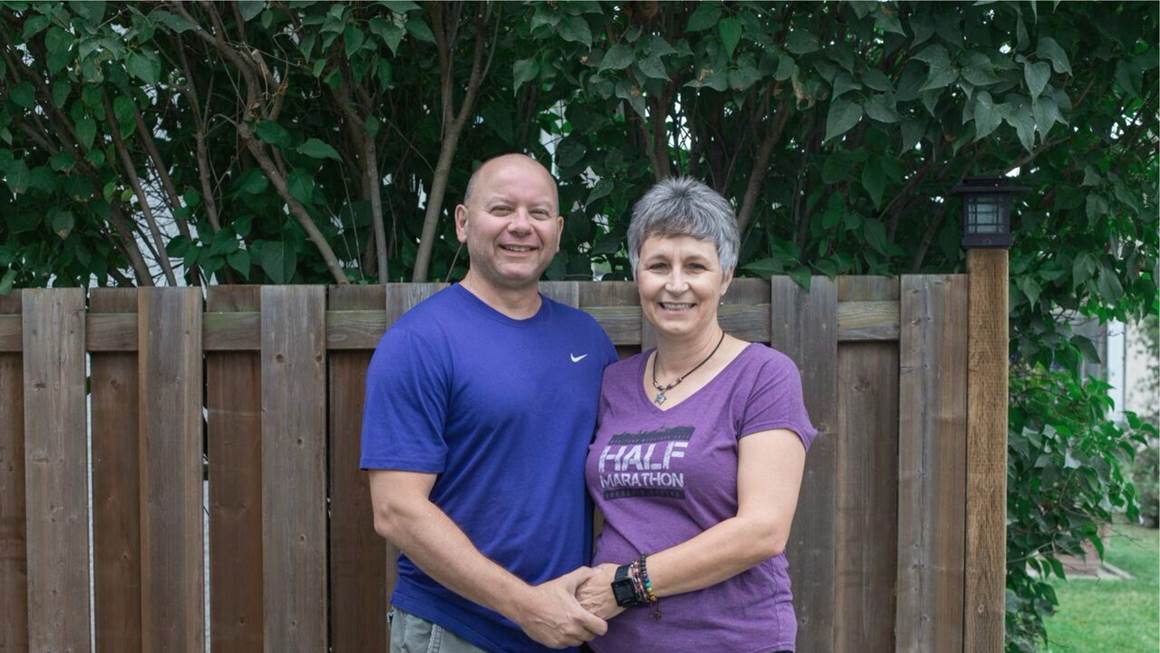It was a few days before Christmas in 2015. Patti Mersereau-Leblanc did a three-mile run, went grocery shopping and roasted vegetables for a potluck that evening at her Winnipeg church. Then, as she was carrying her crockpot to the car before the church service, Patti felt a strange heaviness in her chest and a sharp pain in her chin.
Things got worse during the two-minute drive. “It felt like there was an elephant sitting on my chest,” recalls Patti, then 49. “I couldn't get a big breath. I remember I wanted to saw my chin off because it hurt so bad.”
Despite the pain, Patti didn’t believe that she was having a heart attack. After all, she was a long-time runner training for her first ultra-marathon, and carefully watched what she ate. Then, in the church parking lot, her arm began to tingle. She phoned her husband, Dennis.
“I think I’m having a heart attack. You need to call 9-1-1. I’ll be home in one minute.”
Within minutes the ambulance arrived. En route to St. Boniface Hospital, paramedics confirmed that Patti was having a heart attack.
Dr. Olga Toleva, the cardiologist on call at St. Boniface, quickly ordered tests that would show the blood vessels around Patti’s heart. The images revealed two tears in arteries supplying blood to the heart. They confirmed what Dr. Toleva suspected: Patti’s heart attack was triggered by a dangerous and poorly understood condition known as spontaneous coronary artery dissection (SCAD).
SCAD occurs when an unexpected tear develops in an artery. At one time it was considered rare. Now research shows it’s the underlying cause for roughly 25% of all heart attacks in women under age 60. About 90% of SCAD patients are female, and almost all are young and otherwise healthy.
To complicate matters, most physicians are unfamiliar with this condition, which requires a trained eye and specialized imaging equipment to detect. SCAD doesn’t always show up on a coronary angiogram — a kind of X-ray typically used on heart attack patients. It reveals blood flow to the heart but not structural problems in the vessel wall, such as a tear in a vessel.
Advances in imaging technology have improved detection. One machine in particular, optical coherence tomography (OCT), provides clear pictures of a patient’s arteries.
Knowing what to look for
Patti was lucky that Dr. Toleva was on duty that night. She had interned under Dr. Jacqueline Saw, Canada’s leading expert on SCAD, and recognized SCAD in Patti right away.
Dr. Saw has been investigating SCAD for over 7 years, especially the causes of this mysterious condition. She was recently awarded a research grant from Heart & Stroke and the federal government under the new Advancing Women’s Heart Health Initiative. Her team at the University of British Columbia will perform genetic analysis on 750 SCAD patients, looking for potential inherited links.
“There are a lot of unknowns around what makes an artery weak. Many of these patients have a provoking reason why they have tears,” says Dr. Saw. “Physical stress or severe emotional stress, like a death in the family or job loss, can trigger a SCAD if the arteries are already weak.”
There seems to be a link to a condition known as FMD or fibromuscular dysplasia. FMD results in an overgrowth of cells in the arteries, weakening them and making them more prone to tears. About 70% of SCAD patients have underlying FMD, including Patti. What causes FMD is another mystery researchers are trying to solve. Other conditions may play a role as well, including connective tissue disease, inflammatory disease and multiple pregnancies.
For patients like Patti, having a better understanding of the long-term outcomes can be reassuring, notes Dr. Saw.
Living with SCAD
After her diagnosis, Patti underwent surgery to repair the first tear in her artery. A slightly smaller second tear healed on its own the next day.
While she was in hospital, Patti asked her nurse what she knew about SCAD. “She went to the computer and printed me off something from the Internet. That's pretty much all I had to go on.”
Patti describes the time between her heart attack and when she saw a cardiologist as the longest four months of her life. “I didn’t know what I had. You’re afraid to live. You’re afraid to die. I couldn’t lie on the couch forever. But if I went out for a jog, I might give myself another SCAD.”
Roughly 20% of SCAD patients will experience a second episode within five years. Learning how to reduce emotional and physical triggers could potentially help lower their risk of having another tear.
Patti enrolled in a four-month long cardiac rehabilitation program. She also found support and answers through a Facebook group with 1,800 other SCAD survivors. “It’s incredible how much healing happens when you hear other people’s stories,” she says.
Patti credits cardiac rehab with providing a safe environment to resume exercise. She still believes strongly in leading a healthy lifestyle. She has run four races since her heart attack but acknowledges this experience has taught her to slow down.
“As an athlete you don’t think you need rest. Since my SCAD, I’m learning how to be gentle with myself and to listen to my heart more.”
- Learn more about women and heart disease in the Heart & Stroke 2018 Heart Report.

